Assignment: Step 4: Blog about the process on your personal blog for this course and share how this concept might be used in your library.
I personally use photo sharing all of the time to share photos about my life. I can see how online photo sharing is a great way to demonstrate step-by-step instructions or putting an image with words for online collaboration. This tool is one I can see using both in a professional and personal setting.
Tuesday, April 29, 2008
Monday, April 28, 2008
April Challenge: Cheesecake Pops
We decided to change up the crust a bit this time. We started with some of the cream cheese being not soft enough, so it got lumpy.
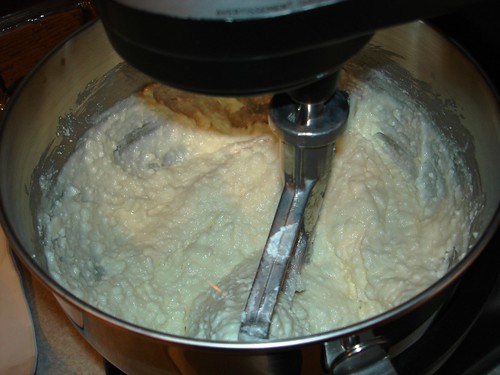
Decided to go with bread pans to keep it moist and tall sides...
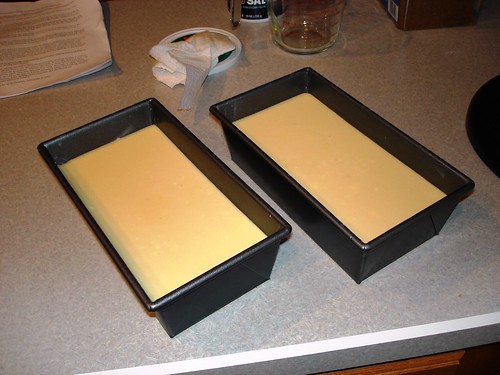
Finished baking...
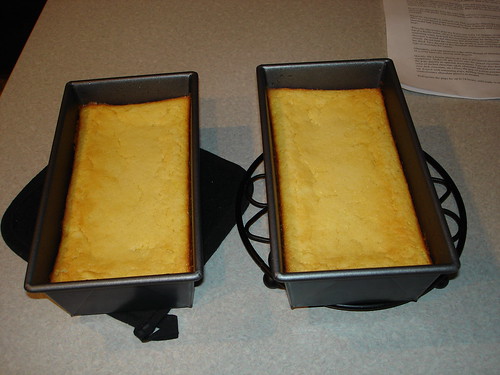
Sizing and cutting the "bar"...
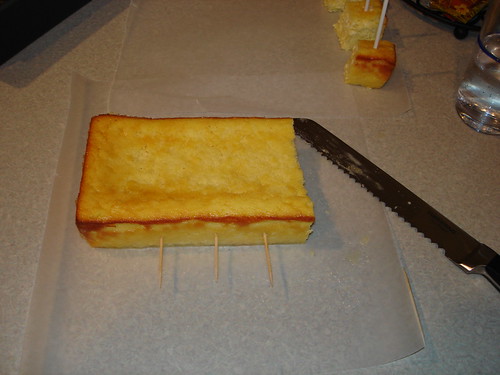
Cheesecake pops, ready to freeze...
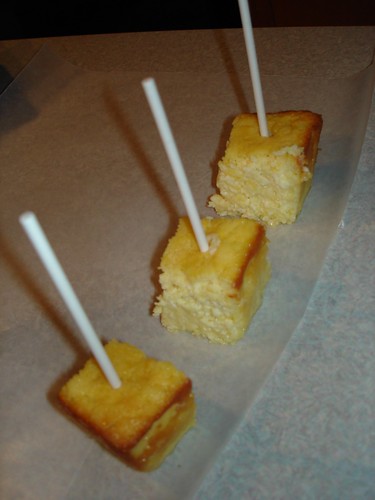
Chocolate and graham cracker finish...
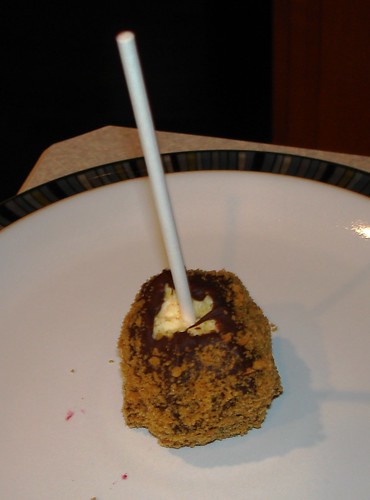
Jam & graham cracker finish...we really liked the fruity, graham cracker crusts. The chocolate was a little too rich (although my husband would disagree...)
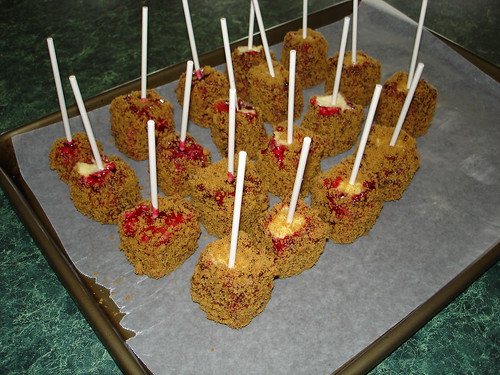
The recipe:
Cheesecake Pops
They are from Sticky, Chewy, Messy, Gooey by Jill O’Connor.
Makes 30 – 40 Pops
5 8-oz. packages cream cheese at room temperature
2 cups sugar
¼ cup all-purpose flour
¼ teaspoon salt
5 large eggs
2 egg yolks
2 teaspoons pure vanilla extract
¼ cup heavy cream
Boiling water as needed
Thirty to forty 8-inch lollipop sticks
1 pound chocolate, finely chopped – you can use all one kind or half and half of dark, milk, or white (Alternately, you can use 1 pound of flavored coatings, also known as summer coating, confectionary coating or wafer chocolate – candy supply stores carry colors, as well as the three kinds of chocolate.)
2 tablespoons vegetable shortening
(Note: White chocolate is harder to use this way, but not impossible)
Assorted decorations such as chopped nuts, colored jimmies, crushed peppermints, mini chocolate chips, sanding sugars, dragees) - Optional
Position oven rack in the middle of the oven and preheat to 325 degrees F. Set some water to boil.
In a large bowl, beat together the cream cheese, sugar, flour, and salt until smooth. If using a mixer, mix on low speed. Add the whole eggs and the egg yolks, one at a time, beating well (but still at low speed) after each addition. Beat in the vanilla and cream.
Grease a 10-inch cake pan (not a springform pan), and pour the batter into the cake pan. Place the pan in a larger roasting pan. Fill the roasting pan with the boiling water until it reaches halfway up the sides of the cake pan. Bake until the cheesecake is firm and slightly golden on top, 35 to 45 minutes.
Remove the cheesecake from the water bath and cool to room temperature. Cover the cheesecake with plastic wrap and refrigerate until very cold, at least 3 hours or up to overnight.
When the cheesecake is cold and very firm, scoop the cheesecake into 2-ounce balls and place on a parchment paper-lined baking sheet. Carefully insert a lollipop stick into each cheesecake ball. Freeze the cheesecake pops, uncovered, until very hard, at least 1 – 2 hours.
When the cheesecake pops are frozen and ready for dipping, prepare the chocolate. In the top of a double boiler, set over simmering water, or in a heatproof bowl set over a pot of simmering water, heat half the chocolate and half the shortening, stirring often, until chocolate is melted and chocolate and shortening are combined. Stir until completely smooth. Do not heat the chocolate too much or your chocolate will lose it’s shine after it has dried. Save the rest of the chocolate and shortening for later dipping, or use another type of chocolate for variety.
Alternately, you can microwave the same amount of chocolate coating pieces on high at 30 second intervals, stirring until smooth.
Quickly dip a frozen cheesecake pop in the melted chocolate, swirling quickly to coat it completely. Shake off any excess into the melted chocolate. If you like, you can now roll the pops quickly in optional decorations. You can also drizzle them with a contrasting color of melted chocolate (dark chocolate drizzled over milk chocolate or white chocolate over dark chocolate, etc.) Place the pop on a clean parchment paper-lined baking sheet to set. Repeat with remaining pops, melting more chocolate and shortening (or confectionary chocolate pieces) as needed.
Refrigerate the pops for up to 24 hours, until ready to serve.

Decided to go with bread pans to keep it moist and tall sides...

Finished baking...

Sizing and cutting the "bar"...

Cheesecake pops, ready to freeze...

Chocolate and graham cracker finish...

Jam & graham cracker finish...we really liked the fruity, graham cracker crusts. The chocolate was a little too rich (although my husband would disagree...)

The recipe:
Cheesecake Pops
They are from Sticky, Chewy, Messy, Gooey by Jill O’Connor.
Makes 30 – 40 Pops
5 8-oz. packages cream cheese at room temperature
2 cups sugar
¼ cup all-purpose flour
¼ teaspoon salt
5 large eggs
2 egg yolks
2 teaspoons pure vanilla extract
¼ cup heavy cream
Boiling water as needed
Thirty to forty 8-inch lollipop sticks
1 pound chocolate, finely chopped – you can use all one kind or half and half of dark, milk, or white (Alternately, you can use 1 pound of flavored coatings, also known as summer coating, confectionary coating or wafer chocolate – candy supply stores carry colors, as well as the three kinds of chocolate.)
2 tablespoons vegetable shortening
(Note: White chocolate is harder to use this way, but not impossible)
Assorted decorations such as chopped nuts, colored jimmies, crushed peppermints, mini chocolate chips, sanding sugars, dragees) - Optional
Position oven rack in the middle of the oven and preheat to 325 degrees F. Set some water to boil.
In a large bowl, beat together the cream cheese, sugar, flour, and salt until smooth. If using a mixer, mix on low speed. Add the whole eggs and the egg yolks, one at a time, beating well (but still at low speed) after each addition. Beat in the vanilla and cream.
Grease a 10-inch cake pan (not a springform pan), and pour the batter into the cake pan. Place the pan in a larger roasting pan. Fill the roasting pan with the boiling water until it reaches halfway up the sides of the cake pan. Bake until the cheesecake is firm and slightly golden on top, 35 to 45 minutes.
Remove the cheesecake from the water bath and cool to room temperature. Cover the cheesecake with plastic wrap and refrigerate until very cold, at least 3 hours or up to overnight.
When the cheesecake is cold and very firm, scoop the cheesecake into 2-ounce balls and place on a parchment paper-lined baking sheet. Carefully insert a lollipop stick into each cheesecake ball. Freeze the cheesecake pops, uncovered, until very hard, at least 1 – 2 hours.
When the cheesecake pops are frozen and ready for dipping, prepare the chocolate. In the top of a double boiler, set over simmering water, or in a heatproof bowl set over a pot of simmering water, heat half the chocolate and half the shortening, stirring often, until chocolate is melted and chocolate and shortening are combined. Stir until completely smooth. Do not heat the chocolate too much or your chocolate will lose it’s shine after it has dried. Save the rest of the chocolate and shortening for later dipping, or use another type of chocolate for variety.
Alternately, you can microwave the same amount of chocolate coating pieces on high at 30 second intervals, stirring until smooth.
Quickly dip a frozen cheesecake pop in the melted chocolate, swirling quickly to coat it completely. Shake off any excess into the melted chocolate. If you like, you can now roll the pops quickly in optional decorations. You can also drizzle them with a contrasting color of melted chocolate (dark chocolate drizzled over milk chocolate or white chocolate over dark chocolate, etc.) Place the pop on a clean parchment paper-lined baking sheet to set. Repeat with remaining pops, melting more chocolate and shortening (or confectionary chocolate pieces) as needed.
Refrigerate the pops for up to 24 hours, until ready to serve.
Thursday, April 10, 2008
Web 2.0: Week 5--Web Documents
Is this the future of all software products? What do you think?
I thoroughly enjoyed working with web documents. It was like a muscular wiki. Having used Office for a while, I did find the simplified Excel and slides to be rather restrictive. Ultimately, with these online capabilities, more and more people will be able to complete their work from anywhere. (Mind you, I do not think they will be able to completely work from home, as there is some merit to f2f meetings and work groups.)
I thoroughly enjoyed working with web documents. It was like a muscular wiki. Having used Office for a while, I did find the simplified Excel and slides to be rather restrictive. Ultimately, with these online capabilities, more and more people will be able to complete their work from anywhere. (Mind you, I do not think they will be able to completely work from home, as there is some merit to f2f meetings and work groups.)
Wednesday, April 09, 2008
The Anatomist, A Book Review
The Anatomist
by Bill Hayes
An enjoyable read, especially since it is closely linked to my career. Bill Hayes takes us through the lives of H.V.Carter (illustrator) and Henry Gray (author) of Gray's Anatomy, a revolutionary book in it's 39th edition (I checked and it's on our shelves in Reserve). While the Hayes takes us through his experience in researching the letters, papers, archives and historic landmarks, he also takes us on his journey through anatomy class. I admire Hayes' ability to keep up with the anatomy students. Hayes has the ability to draw the reader in and take them along for the ride.
This book wasn't as gruesome as Mary Roach's Stiff: The Curious Lives of Human Cadavers. Or I'm getting used to this topic.
by Bill Hayes
An enjoyable read, especially since it is closely linked to my career. Bill Hayes takes us through the lives of H.V.Carter (illustrator) and Henry Gray (author) of Gray's Anatomy, a revolutionary book in it's 39th edition (I checked and it's on our shelves in Reserve). While the Hayes takes us through his experience in researching the letters, papers, archives and historic landmarks, he also takes us on his journey through anatomy class. I admire Hayes' ability to keep up with the anatomy students. Hayes has the ability to draw the reader in and take them along for the ride.
This book wasn't as gruesome as Mary Roach's Stiff: The Curious Lives of Human Cadavers. Or I'm getting used to this topic.
Friday, April 04, 2008
Web 2.0: Week 4--Social Bookmarking
Can you see the potential of this tool for research assistance? Or just as an easy way to create bookmarks that can be accessed from anywhere?
After having had a chance to utilize social bookmarking, I have mixed feeling about this tool.
On one hand, this tool proves useful for a social network of people in research assistance. In addition to this, if the people utilizing this service use similar terms for the same types of information, the same users could benefit from the group knowledge. Because this tool is online, users are less likely to be subject to a "group thinking" mentality and can share their uniqueness in bookmarking and tagging.
On the other hand, social bookmarking is only as good as the people who use it. If a veteran cataloguer were to use his/her skills to socially bookmark, then many could benefit from his/her expertise that would be bound by cataloging rules. Because, social bookmarking is open to everyone, language, dialects and general understanding of words are certainly barriers for its usefulness.
After having had a chance to utilize social bookmarking, I have mixed feeling about this tool.
On one hand, this tool proves useful for a social network of people in research assistance. In addition to this, if the people utilizing this service use similar terms for the same types of information, the same users could benefit from the group knowledge. Because this tool is online, users are less likely to be subject to a "group thinking" mentality and can share their uniqueness in bookmarking and tagging.
On the other hand, social bookmarking is only as good as the people who use it. If a veteran cataloguer were to use his/her skills to socially bookmark, then many could benefit from his/her expertise that would be bound by cataloging rules. Because, social bookmarking is open to everyone, language, dialects and general understanding of words are certainly barriers for its usefulness.
Subscribe to:
Posts (Atom)